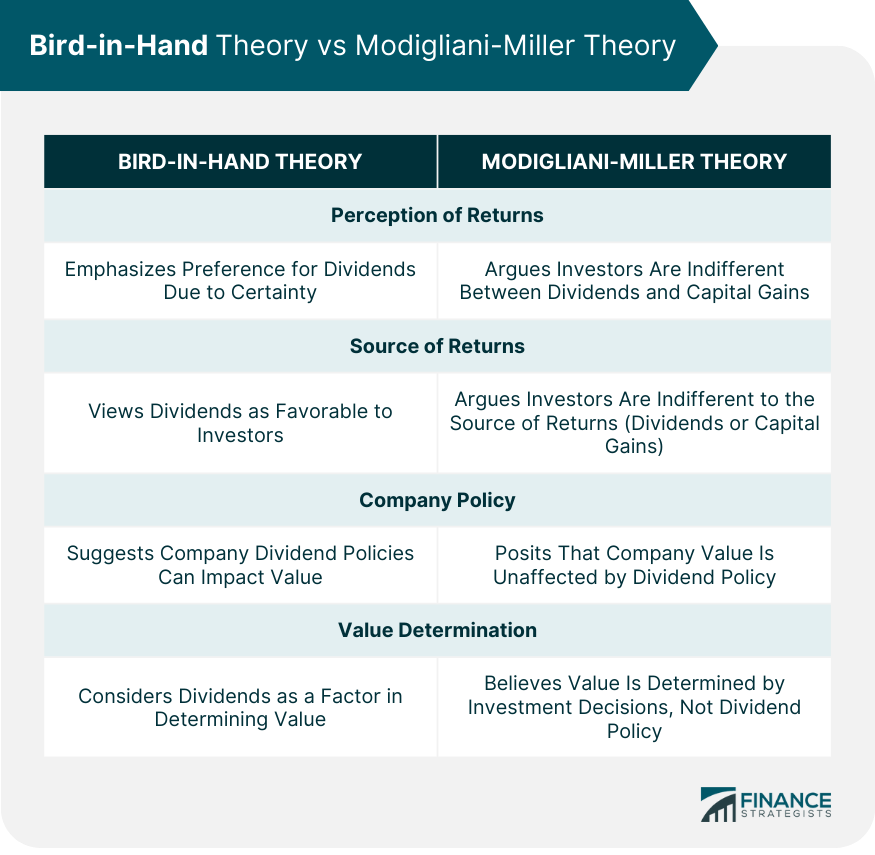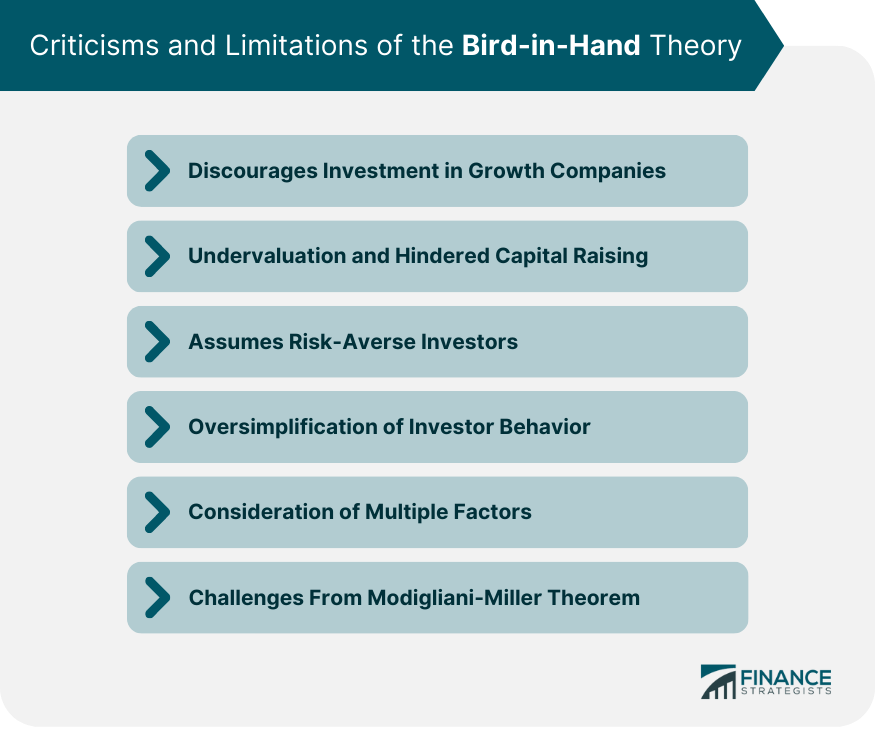The "Bird in Hand" theory is a financial principle that suggests investors have a preference for dividends over potential future capital gains. The theory posits that the certainty of receiving dividends, akin to having a bird in the hand, is preferable to the uncertainty of future capital gains, the proverbial "two in the bush". This financial concept is named after the age-old proverb, emphasizing the value of certainty over potential yet uncertain rewards. The Bird in Hand theory was first proposed by Myron Gordon and Eli Shapiro in 1956 as a counterpoint to the Modigliani-Miller dividend irrelevance theory. It rests on the idea that investors perceive dividends as certain and capital gains as uncertain, leading them to prefer the former. This preference is believed to drive company policies regarding dividends and capital structure. The Bird in Hand theory rests on the notion that investors value the certainty of dividend payments over the potential of capital gains. This perception of risk and reward is rooted in the idea that a guaranteed return in the form of dividends is more valuable than the possibility of a higher return through capital gains. This theory suggests that companies that offer regular dividends are more attractive to investors and can therefore command a higher market price for their shares. In the world of investing, the Bird in Hand theory is often used to explain investor behavior regarding dividends and capital gains. Investors, according to this theory, are more likely to invest in companies that pay regular dividends because these payments offer a tangible return on investment. This preference may lead investors to undervalue companies that don't pay dividends, even if they have strong growth prospects, due to the perceived risk associated with capital gains. The preference for dividends over capital gains is a key tenet of the Bird in Hand theory. Investors, fearing the uncertainty of the market, may prefer a smaller, sure payout now (dividends) over a potentially larger, uncertain payout in the future (capital gains). This preference might be particularly strong in volatile markets or in situations where future growth is uncertain. The Bird in Hand theory is often contrasted with the Modigliani-Miller dividend irrelevance theory. Proposed by Franco Modigliani and Merton Miller, this theory argues that investors are indifferent between dividends and capital gains. It posits that the value of a firm is determined by its investment decisions, not its dividend policy. This is in stark contrast to the Bird in Hand theory, which suggests that dividends do matter to investors. The primary difference between these two theories lies in the perception of dividends and capital gains. While the Bird in Hand theory suggests that investors prefer dividends due to their certainty, the Modigliani-Miller theory argues that investors are indifferent to the source of their returns, be it dividends or capital gains. Another notable difference is the role of company policy. The Bird in Hand theory suggests that company policies regarding dividends can affect the company's value in the eyes of investors. In contrast, the Modigliani-Miller theory posits that company value is unaffected by its dividend policy. The "two in the bush" aspect of investing refers to the potential yet uncertain capital gains that could be earned in the future. This part of the proverb highlights the risk and uncertainty associated with investing for capital gains. The future is uncertain, and the potential gains promised by an investment are not guaranteed. This potential for high reward, however, is also coupled with a higher level of risk. In today's complex and volatile financial markets, the Bird in Hand theory continues to have relevance. Given the uncertainty and unpredictability of the markets, many investors still prefer the certainty of dividend payments. This preference can be seen in the premium often associated with shares of companies with a steady record of paying dividends. Many mature and financially stable companies, such as those in utilities, consumer goods, and real estate, typically adopt the Bird-in-Hand approach, offering consistent dividends to their shareholders. For example, utility companies like Duke Energy and consumer goods companies like Procter & Gamble have long histories of paying regular dividends. Investors seeking steady income streams often gravitate toward these types of companies. The Bird-in-Hand theory significantly influences investor behavior. It explains why investors might favor companies that offer consistent dividends, even if their growth prospects are modest. The theory also provides insight into why some investors may avoid companies that don't pay dividends, even if they have strong growth potential. The fear of uncertainty and the desire for immediate returns can powerfully shape investor decisions. Despite its insights, the Bird-in-Hand theory is not without potential disadvantages or drawbacks. One significant critique is that it may discourage investment in growth companies that reinvest profits rather than pay dividends. This can lead to an undervaluation of these companies and potentially hinder their ability to raise capital. Additionally, the theory assumes that investors are risk-averse and prefer certainty, which may not always be the case. Many financial analysts and economists argue that the Bird-in-Hand theory oversimplifies investor behavior. They suggest that investors consider a range of factors when deciding where to invest, not just dividends versus capital gains. Moreover, the Modigliani-Miller theorem and others have challenged the premise that dividends matter to investors, leading to an ongoing debate in the financial world. The Bird-in-Hand theory offers valuable insights into investor preferences for dividends over potential capital gains. It emphasizes the value of certainty and explains why investors may prefer smaller, sure payouts in the form of dividends rather than larger, uncertain payouts from capital gains. This theory influences investor behavior, leading them to favor companies that offer consistent dividends and potentially undervalue those that reinvest profits. However, criticisms and limitations exist. The theory may discourage investment in growth companies and assumes that all investors are risk-averse and prefer certainty, which may not always be the case. Financial analysts and economists argue that investor decision-making is more complex, considering various factors beyond dividends versus capital gains. The Bird-in-Hand theory stands in contrast to the Modigliani-Miller dividend irrelevance theory, which suggests investors are indifferent to the source of returns. Ultimately, understanding the Bird-in-Hand theory provides valuable insights into investor behavior, but it is essential to consider its limitations and ongoing debates in the financial world.What Is a Bird in Hand?
Understanding the Bird-in-Hand Theory
Explanation of the Theory
Application in Investing
Preference for Dividends Over Capital Gains
Comparison to Other Financial Theories
Modigliani-Miller Dividend Irrelevance Theory
Differences Between Bird-in-Hand Theory and Modigliani-Miller Theory

"Two in the Bush" Aspect of Investing
Application of the Bird-in-Hand Theory
Relevance in Today's Financial Markets
Examples of Bird-in-Hand Approach in Investing
Influence on Investor Behavior
Criticisms and Limitations of the Bird-in-Hand Theory
Potential Disadvantages or Drawbacks
Criticisms from Financial Analysts and Economists

Final Thoughts
Bird in Hand FAQs
The Bird-in-Hand theory is a financial principle suggesting that investors prefer the certainty of dividend payments over the potential for future capital gains. It gets its name from the proverb, "a bird in the hand is worth two in the bush," symbolizing the preference for certainty over uncertainty.
In the context of investing, the Bird-in-Hand theory suggests that investors value companies that offer regular dividends, viewing these payments as a tangible return on investment. Thus, according to this theory, companies offering regular dividends can command a higher market price for their shares.
The Bird-in-Hand theory posits that investors prefer dividends due to their certainty and that this preference influences a company's market value. In contrast, the Modigliani-Miller dividend irrelevance theory maintains that investors are indifferent to dividends and capital gains, and a company's value is determined by its investment decisions, not its dividend policy.
Critics argue that the Bird-in-Hand theory oversimplifies investor behavior and assumes investors are risk-averse, which may not always be the case. Additionally, the theory may discourage investment in growth companies that reinvest profits rather than pay dividends, potentially hindering their ability to raise capital.
Despite the evolution of financial markets, the Bird-in-Hand theory remains relevant. It explains why many investors still prefer the certainty of dividends, especially in volatile or unpredictable markets. This theory can influence investor behavior, shaping their preference for companies with a steady record of paying dividends.
True Tamplin is a published author, public speaker, CEO of UpDigital, and founder of Finance Strategists.
True is a Certified Educator in Personal Finance (CEPF®), author of The Handy Financial Ratios Guide, a member of the Society for Advancing Business Editing and Writing, contributes to his financial education site, Finance Strategists, and has spoken to various financial communities such as the CFA Institute, as well as university students like his Alma mater, Biola University, where he received a bachelor of science in business and data analytics.
To learn more about True, visit his personal website or view his author profiles on Amazon, Nasdaq and Forbes.











